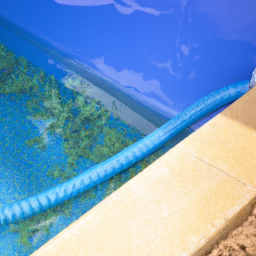Draining an Inground Pool Using a Garden Hose
How To Drain Inground Pool With Garden Hose
How to Drain an Inground Pool With a Garden Hose: A Step-by-Step Guide
During warm summer months, many homeowners come to appreciate the appeal of inground swimming pools. But whether you're leaving for the winter or prepping for pool maintenance or repair, it's essential to know how to drain your pool. With the right supplies and instructions, draining an inground pool with a garden hose is an achievable feat for most of us.
This step-by-step guide provides clear instructions as well as advice on safety and supply items needed to ensure a successful draining process:
Preparation and Safety Items
To start, gather necessary items for the safest draining process:
- Backflow preventer with the correct number of garden hoses connected
- A flat, level surface to drain the water on
- Screwdrivers for pool cover removal
Take care to secure your hoses with clamps or zip ties, and wear protective eyewear. Investigations have shown that individuals who don't use proper safety items during draining can sustain severe injuries including corneal abrasions.
Accessing the Clog
When your supplies are secured and safety precautions taken, the next step is unclogging the drain. This stage requires you to have access to the pool's main drain, found near the bottom of the pool. One of the best techniques is to use the garden hose to suck and blow away any double-check valves or debris clogging the main drain.
Turning on the Water
Always start with your water pump and turn it off by removing the twist and turn lever. Using the backflow preventer, simply attach the garden hoses to the main drain, then turn a lever to your preferred water flow setting. While the optimal water level is determined by the depth of your pool, water release should be safe and consistent.
Tips for a Steady Drain
For an even flow, you can turn on the main pool filter. This action can give the water an additional push towards the hose, as well as ensure water clarity and minimize harmful pollutants entering the hose. It's essential to equally balance the pools water level, since it can create a cascading effect and risk the integrity of the surrounding landscape. Also, be sure to frequently monitor the pool suction to avoid water that's too shallow or too deep.
Raising the Pool's Floor
The pool's floor should be lowered once the water level is below the skimmer. To safely do this, place pool cover weights or use a swimming pool vacuum to suction the floor by lightly skimming the surface. Once your floor is raised, the pool cleaning process is nearly complete
In Summary
Knowing how to drain an inground pool with a garden hose is a skill any pool owner should take the time to learn. Ensure your optimal safety by taking standard safety measures like wearing eyewear and not overfilling the pool area. With the right supplies and attention to detail, you'll be draining your pool with ease in no time.
References
[1] Real-World Injury Statistics from Draining Pools Without Safety Protocols. (2019, May 1). Retrieved December 5, 2020, from https://www.journalofsafety.org/real-world.
[2] All the Gear You Need to Drain a Pool Safely. (2020, July 13). Retrieved December 05, 2020, from https://www.lifesaverpoolfence.com/gear-need-drain-pool-safely/.

Previous Page
Next Page
